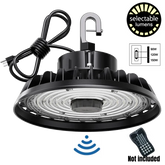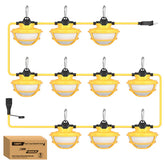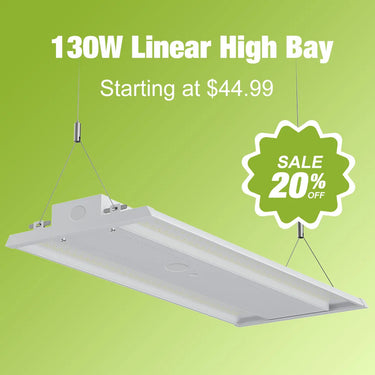What is an LED high bay light? High Bay Buyer’s Guide!
When it comes to lighting large commercial spaces like warehouses, factories, and gymnasiums, high bay lighting is the go-to solution. But with so many options available, how do you choose the right one? Oftentimes, first time or even seasoned buyers of LED high bays find it difficult to understand and shop for these new lights, due to differences in wattage to lumen ratios and a considerably wider range of options and choices than what was previously available. Recognizing this need for clarification, we have compiled one of the most comprehensive buyers guides available to assist in the selection of the best LED high bay light for a variety of applications. We also have included information regarding the technical and performance benefits of LED lighting, to help buyers understand why they should choose LEDs over conventional types of lighting fixtures for their commercial and industrial applications.
What is High Bay Lighting?
As discussed earlier, High Bay LED lights are specially designed lights, commonly used in large spaces with ceiling height ranging from 20 to 40 feet. Depending upon your requirement and design of the facility you can either use chains or can directly attach these high bay lights to the ceiling.
Why Choose LED High Bay Lights?
LED high bay lights have become the industry standard for commercial lighting. Here’s why:
- Energy Efficiency: LED lights consume up to 50-70% less energy than traditional lighting options like metal halide or high-pressure sodium lamps.
- Long Lifespan: With an average lifespan of 50,000 to 100,000 hours, LED high bay lights significantly reduce maintenance costs.
- Superior Lighting Quality: LEDs offer better color rendering (CRI >80) and customizable color temperatures (3000K-6500K) to suit different environments.
- Eco-Friendly: LED lights are free of toxic materials like mercury and are fully recyclable.
Key Factors to Consider When Choosing High Bay Lights
Selecting the right high bay light depends on several factors:
-
Ceiling Height
- For ceilings 15-20 feet, choose fixtures with a lower wattage (e.g., 100W-150W).
- For ceilings 30-40 feet, opt for higher wattage (e.g., 200W-400W) to ensure adequate illumination.
-
Space Size and Layout
- Calculate the total lumens needed based on the square footage of your space.
- Consider the beam angle: Narrow beams (e.g., 60°) are ideal for focused lighting, while wide beams (e.g., 120°) provide broader coverage.
-
Lighting Purpose
- Warehouses: Prioritize brightness and durability.
- Retail Spaces: Focus on color rendering and aesthetics.
- Manufacturing Facilities: Ensure flicker-free lighting to reduce eye strain.
-
Energy Efficiency
- Look for fixtures with a high lumens-per-watt (LPW) ratio.
- Check for certifications like ENERGY STAR or DLC to ensure energy-saving performance.
-
Durability and Maintenance
- Choose fixtures with an IP65 rating or higher for dust and water resistance.
- Opt for modular designs that allow easy replacement of components.
Real-World Example: A Warehouse Transformation
A 50,000 sq. ft. warehouse in Texas replaced its outdated metal halide lights with 200W LED high bay lights. The results:
- Energy Savings: Reduced electricity costs by 65%.
- Improved Lighting: Enhanced visibility led to a 20% increase in productivity.
- Maintenance Reduction: No bulb replacements in the past 3 years.
Installation Tips for High Bay Lights
- Professional Installation: For high ceilings, hire a licensed electrician to ensure safety and compliance.
- Proper Spacing: Follow the manufacturer’s guidelines for fixture spacing to avoid dark spots.
- Dimmable Options: Consider dimmable LED high bay lights for spaces with varying lighting needs.
Frequently Asked Questions (FAQs)
-
How long do LED high bay lights last?
- Typically 50,000 to 100,000 hours, depending on usage and quality.
-
Are LED high bay lights worth the investment?
- Yes, the energy savings and reduced maintenance costs often result in a payback period of 1-3 years.
-
Can LED high bay lights be used outdoors?
- Only if they have a suitable IP rating (e.g., IP65 for dust and water resistance).

















